Jack Dempseys are large cichlids found throughout Mexico and down into Central America. They get their name from the legendary boxer Jack Dempsey, known for his aggressive, heavy hitting fighting style.
That being said, Jack Dempseys have a slightly overblown reputation in the aquarium community. They are large, territorial, and vicious when breeding. However they won’t kill their tank mates for simply existing. Usually.
These traits apply to the majority of large Central and South American cichlids. Still, we need to choose tank mates that can withstand or match the occasional nip or chase when finding tank mates for a Jack Dempsey.
About Jack Dempseys
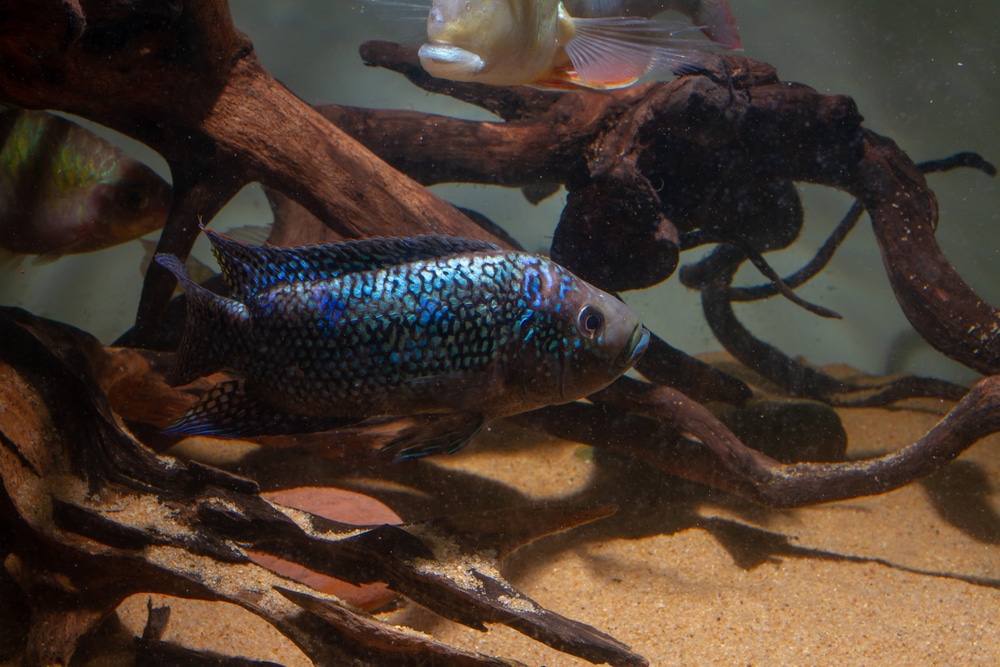
Several cichlid species can match Jack Dempseys for temperament and a few have even worse manners. That being said, here are things that bring out the worst in Jack Dempseys:
- Keeping them in small aquariums: being a territorial cichlid, Jack Dempseys will dig, uproot plants, and claim a patch of gravel, usually centrally located as theirs and theirs alone. Any fish that intrudes will be chased to the perimeter and bitten if they don’t move quickly enough. Male Jack Dempseys can reach up to a foot in length and should be kept in aquariums no smaller than 75-90 Gallons. As a minimum, assuming they have no other tank mates.
- Not enough decorations: Driftwood, hardy plants, and rocks help break up line of sight and keep Jack Dempseys from being continually triggered into territorial responses. This goes in hand with providing an aquarium spacious enough for them to feel secure.
- Raising them with prey sized fish: predation isn’t aggression and while that cute 2 inch Jack Dempsey may get along fine with your Danios and Dwarf Gourami they will eventually be snacks once it matures.
- A breeding pair of Jack Dempseys: like most large cichlids Jack Dempseys pair off and protect both eggs and fry. Their territory extends even further than usual when breeding and they will make life very difficult for any fish sharing an aquarium under 120 gallons in size.
It’s worth mentioning that there is an Electric Blue Jack Dempsey as well that’s pricier but has an iridescent blue sheen covering its entire body. Combined with their red eyes they are striking to behold but are significantly less aggressive and more delicate in constitution thanks to heavy inbreeding.
Normal Jack Dempseys are covered in shining blue scales with a grey to purple background. Males are larger and more colorful than females and achieve best color when given a varied diet rich in meaty prey like fish and shellfish. Many prepared formulas also achieve the right balance of variety, especially Omega One Super Color, which contains krill and other foods high in carotenoid pigments.
When kept with the right fish Jack Dempseys will still be boisterous but not cause too much trouble. Aggressive community tanks are very much a thing! Here are 15 tank mates to consider for your Jack Dempsey aquarium!
15 Best Jack Dempsey Tank Mates
Here are a few potential Jack Dempsey tank mates that we recommend:
Green Terror
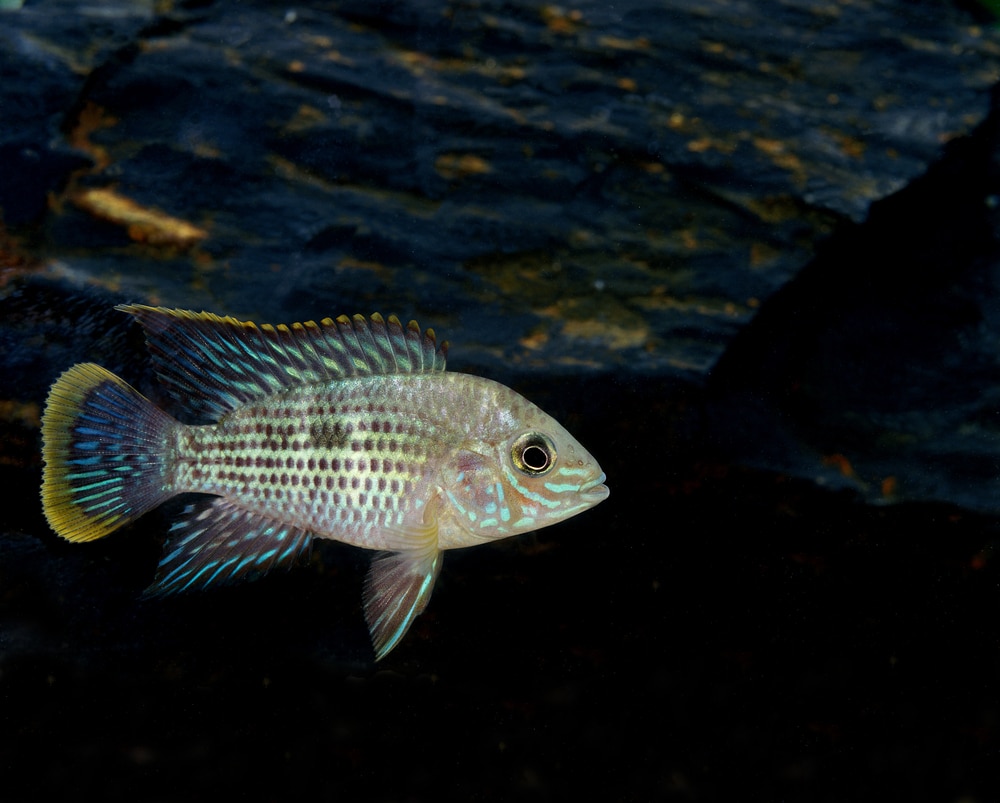
Green Terrors and Jack Dempseys are pretty evenly matched in terms of temperament and size. When kept together you can expect both species to flare their gills in standoffs now and again but will rarely do lasting harm unless the aquarium is too small for both species to secure territories.
The males of both cichlid species reach roughly a foot in length. Green Terrors have an even stockier build and males have a very pronounced nuchal hump on the forehead that thickens as they mature.
Like Jack Dempseys they also prefer neutral to alkaline water conditions and a variety of live, prepared, and thawed meaty foods for good color and health.
Green Terrors have a color pattern that nicely contrasts the somber blue and purple tones of Jack Dempseys. Male Green Terrors have brilliant green edged scales with white to red trim on their dorsal fins.
- Scientific Name: Andinoacara rivulatus
- Origin: South America
- Size: Up to 10 inches
- Temperament: Semi-aggressive; territorial
Jaguar Cichlid
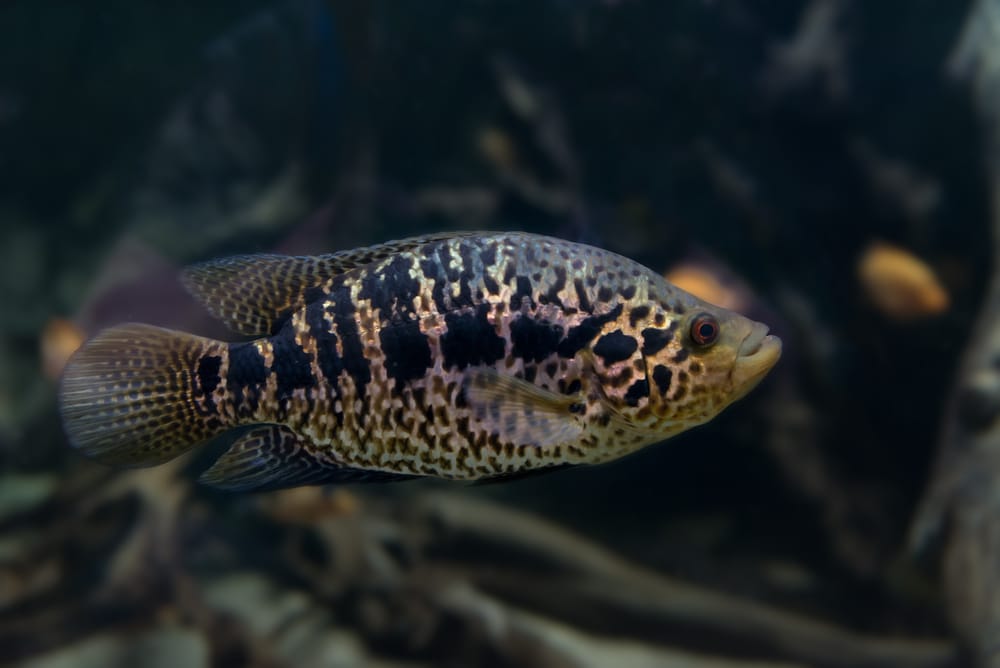
The Jaguar Cichlid is the largest of the Central American cichlids and a top predator in its home region. While they can reach 2 feet in the wild they don’t grow nearly as large when kept in aquaria.
You should be careful when keeping Jaguar Cichlids with Jack Dempseys because Jaguars are, pound for pound, even more aggressive. Male Jaguars are also 50% larger than the largest Dempsey and have seriously large teeth that they use to snag fast moving prey items.
So long as your aquarium is 180 gallons or above the two species do well together and are a great start to a Central American biome community tank. Just don’t count on any decorations staying in place for very long!
- Scientific Name: Parachromis managuensis
- Origin: Central America
- Size: 16-24 inches
- Temperament: Aggressive; territorial; predatory
Midas Cichlid
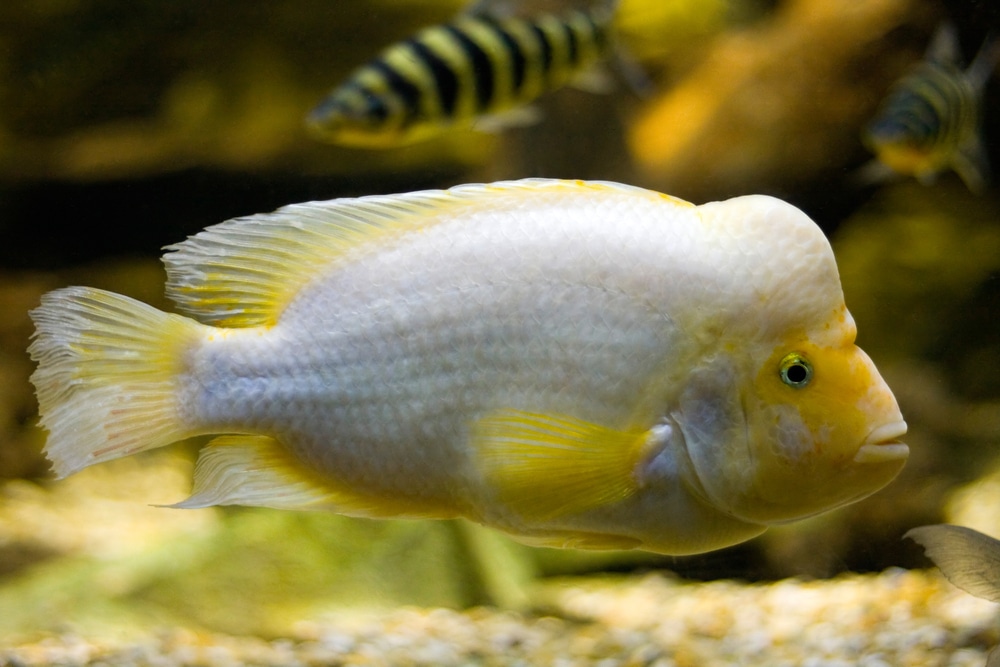
Midas Cichlids are Central American natives found in lakes throughout Costa Rica and Nicaragua. Similar in length and personality to Jack Dempseys, Midas Cichlids are even more thick-bodied, with a square, brick-like build and a thick nuchal hump in mature males.
If you’re a fan of Flowerhorn Cichlids it’s obvious where they got their genes for bulk from. Midas Cichlids, along with Red Devils, Trimacs, and other species from the region have all contributed to the melting pot. But Midas Cichlids are considered the likeliest source of the nuchal hump and heavy build.
While territorial, Midas Cichlids are on the mild side for the fish of the region. They love to dig and flare their fins in threat displays but have small mouths relative to their size. Midas Cichlids are also very owner-conscious and are said to recognize their keepers over other people, who may instead get threat displays or even bites.
Also consider the closely related Red Devils (Amphilophus labiatus) but keep in mind they are not only larger than Jack Dempseys (up to 15 inches) but even more aggressive. In a smaller tank they may end up maiming or killing the Dempsey.
- Scientific Name: Amphilophus citrinellus
- Origin: Central America
- Size: 12 inches
- Temperament: Semi-aggressive; territorial
Firemouth Cichlid
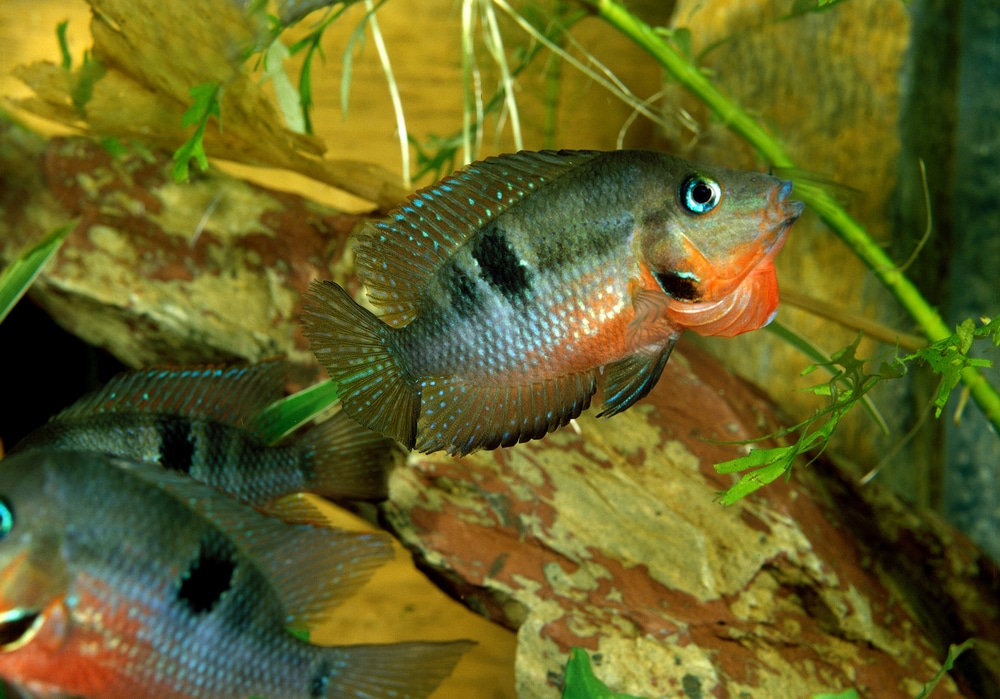
Firemouth Cichlids are a great choice for aquarists who have smaller tanks and can’t make room for several tank busters. They get their name from their robin-red breasts that are particularly vivid in males.
Firemouths also have especially large scarlet gill arches they flare in typical cichlid fashion when jousting with one another or other cichlids. While smaller than Jack Dempseys they will do fine so long as the tank is at least 55 gallons in size. This way the Firemouths will have room to respect the Jack Dempsey’s territory.
Since they come from the same region of the world Firemouths have identical needs in terms of water quality. Tropical temperatures from 75-82F are ideal and neutral to moderately hard water (pH 7.0-8.0) is preferred. Firemouths are also salt-tolerant and do well in moderately brackish conditions.
- Scientific Name: Thorichthys meeki
- Origin: Mexico, Central America
- Size: Up to 6 inches
- Temperament: Semi-aggressive
Convict Cichlid
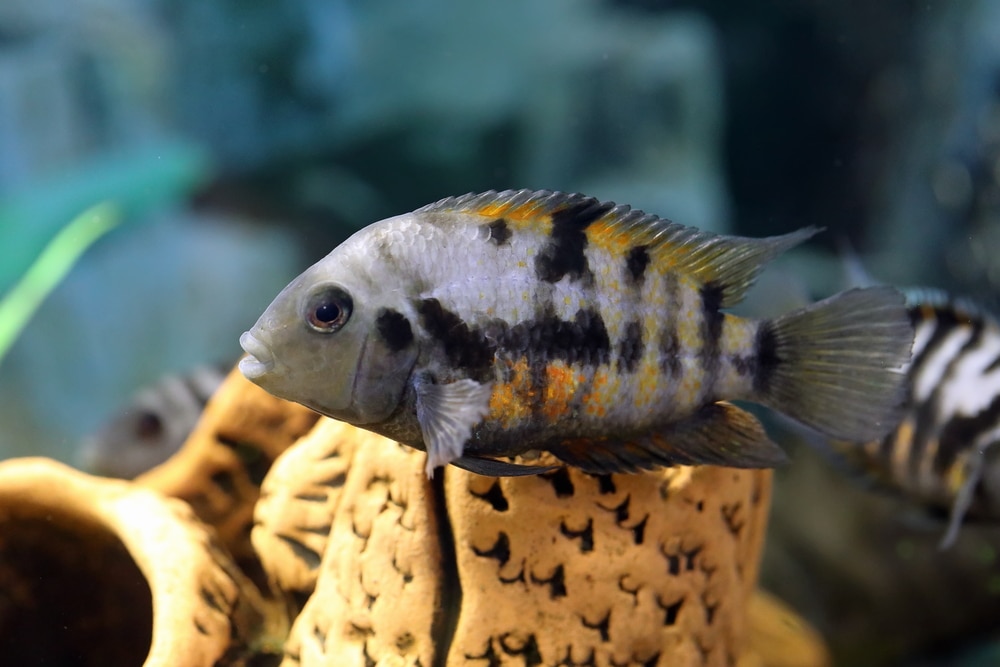
Convict Cichlids are one of the most popular aquarium fish in the world. They get their name from their subtle yet attractive vertical stripes and grey to white background coloration.
Females are smaller and usually have orange scales mixed in with grey on their bellies. Males are larger, have trailing dorsal fins, and may even grow a small nuchal hump as they age. Convict Cichlids are hardy, relatively small, and very easy to breed, making them an ideal first cichlid for new hobbyists.
While quite a bit smaller than Jack Dempseys, Convict Cichlids pack a lot of feisty personality in a smaller package. A breeding pair of Convicts will vigorously fend off a Jack Dempsey who gets too interested about their eggs or fry.
While too small to harm a Jack Dempsey they are ferocious parents and can easily maim or kill smaller fish when breeding in a cramped tank.
- Scientific Name: Amatitlania nigrofasciata
- Origin: Central America
- Size: 4 to 5 inches
- Temperament: Semi-aggressive
Common Plecostomus
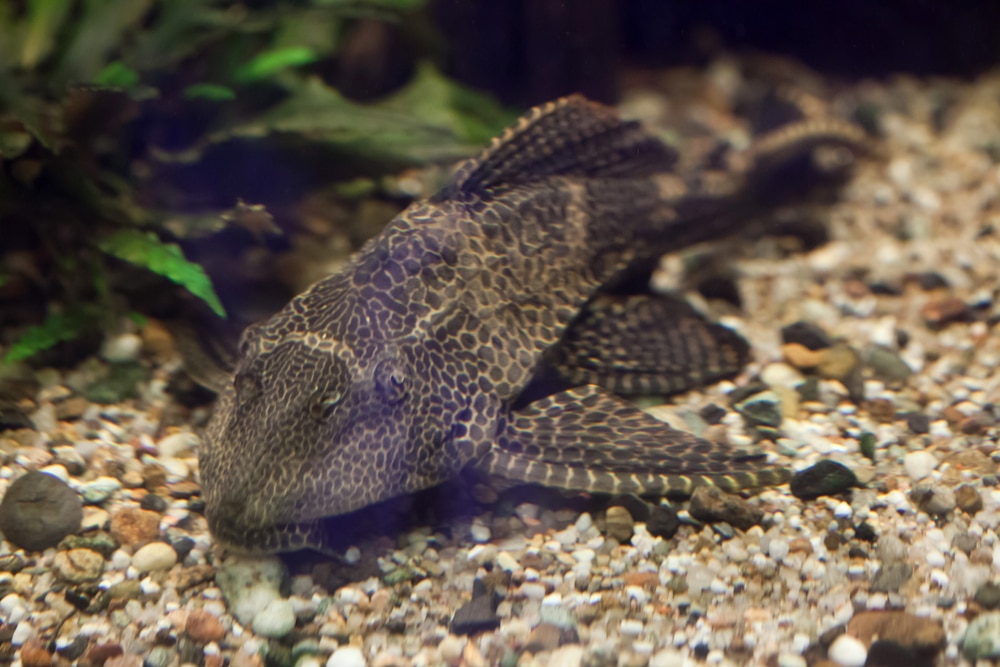
Common Plecostomus are some of the most popular fish in the hobby, though given their final adult size they shouldn’t be. Few aquarists are set up to care for a 2 foot long armored catfish!
However their appetite for algae makes them indispensable for many hobbyists. And their size and armored flanks make them a good match for Jack Dempseys. While they tend to bumble around on the bottom with no respect for territorial cichlid boundaries they will weather the occasional nip or chase with no lasting harm done.
As they mature few tanks provide enough algae to keep them well fed. So make sure you keep a mixture of prepared algae wafers on hand.
Common Plecostomus also enjoy blanched vegetables like cauliflower stalks and cucumber! Their vegetarian habits are a stark contrast to the carnivorous Jack Dempsey and make feeding easier since Plecos are slow eaters.
- Scientific Name: Hypostomus plecostomus
- Origin: Central America
- Size: Up to 24 inches
- Temperament: Peaceful
Hoplo Catfish
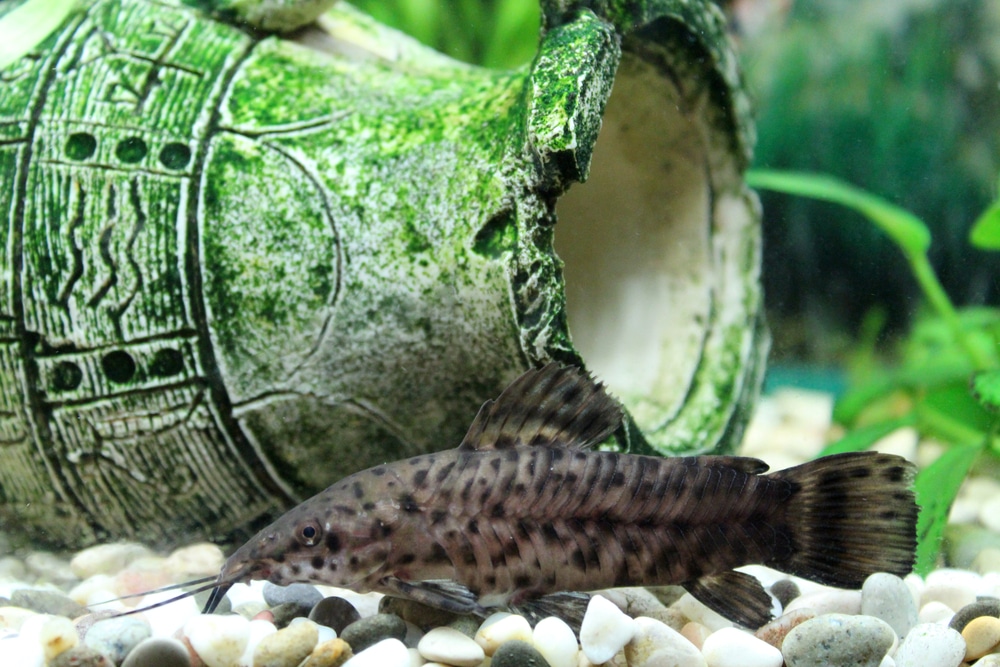
Corydoras are popular community tank fish but would be little more than snacks for an adult Jack Dempsey. Fortunately the closely related Hoplo Catfish is an extra large species that will do well with Dempseys.
Hoplo Catfish are 8 inch long catfish with thick scales and fin spines to ward off attacks from predators. Despite their fearsome appearance they are active, rather bumbling fish that constantly swim all around the tank rather than sticking to the bottom like most catfish.
Unlike Corydoras, Hoplos are fine when kept singly or in pairs. However they will gladly school if your tank is spacious enough.
They are peaceful and a good match but also have tiny mouths, which keeps them from eating the same large items you might feed your Jack Dempseys. Instead offer Hoplo Catfish thawed Brine Shrimp, Tubifex, and appropriately sized pellets and flakes.
Hoplo Catfish are fascinating when spawning as well. The male builds a bubble nest similar to a Betta’s, and adds bits of plants chopped up using his sharp-edged pectoral fins. After mating he drives away the female and any curious fish in cichlid parenting fashion until the eggs hatch!
- Scientific Name: Megalechis thoracata
- Origin: South America
- Size: Up to 8 inches
- Temperament: Peaceful
Featherfin Synodontis
Featherfin Synodontis are one of the largest commonly available catfish in this diverse group. They are also known as Featherfin Squeakers as they produce an audible squeak or chirp when threatened or communicating with one another.
Featherfins are closely related to the popular Upside-down Catfish (Synodontis nigriventris) and will occasionally invert as well, especially when feeding on flakes from the surface of the water.
Featherfin Synodontis are very eager feeders, splashing water around and often intimidating smaller tank mates when it’s time to eat! While large and active they are peaceful, hardy, and have an impressively large dorsal fin with long streamers.
They are also scaleless fish and while large enough to coexist with Jack Dempseys, they should not be kept in smaller aquaria where they will be bullied constantly. Scaleless fish are especially susceptible to skin diseases and open wounds are an invitation for bacterial and fungal infections.
- Scientific Name: Synodontis eupterus
- Origin: West Africa
- Size: Up to 12 inches
- Temperament: Peaceful
Striped Raphael Catfish
Striped Raphael Catfish are a medium sized nocturnal fish from South America that does well with Jack Dempseys. Peaceful and easy to care for, they have armored flanks and will croak if disturbed.
When caught in a net they can be very noisy, seeking to frighten off a potential predator. Beware of their spiny fins, which are designed to pinch against their hard scales and can catch both netting and fingers in their grasp.
Young Raphael Catfish are boldly patterned because they fill the cleaner niche in nature, similar to Cleaner Wrasses and Cleaner Shrimp. You’re unlikely to see this in your aquarium as Jack Dempseys aren’t from the same region.
As they mature they stick to the bottom and their eye catching striped pattern dulls somewhat. Fully grown they happily devour anything organic that hits the bottom, including worms, live and frozen foods, flakes, and pellets.
- Scientific Name: Platydoras armatulus
- Origin: South America
- Size: Up to 8 inches
- Temperament: Peaceful
Iridescent Shark
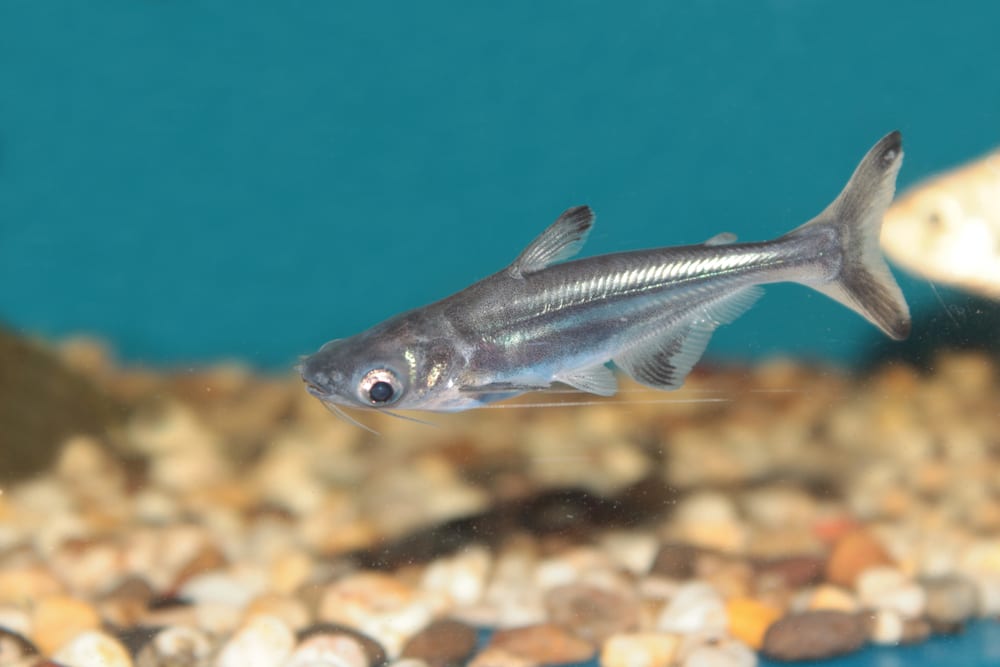
Iridescent Sharks are pretty common in pet stores. Considering how large they get, though, they really should not be. But if you’re keeping a Jack Dempsey you may have enough space for one of these true tank busters!
One is okay but several is better because Iridescent Sharks are schooling catfish! While very large, active, and opportunistic feeders they are peaceful midwater dwellers that are fast enough to avoid a moody Jack Dempsey.
Once they approach their adult size it can be hard to find a new home for them so think carefully on whether you want to own an Iridescent Shark. I discuss them in even more detail in my 9 Types of Freshwater Sharks article!
- Scientific Name: Pangasionodon hypophthalmus
- Origin: Southeast Asia
- Size: 3 to 4 feet
- Temperament: Peaceful; schooling
Giant Danios
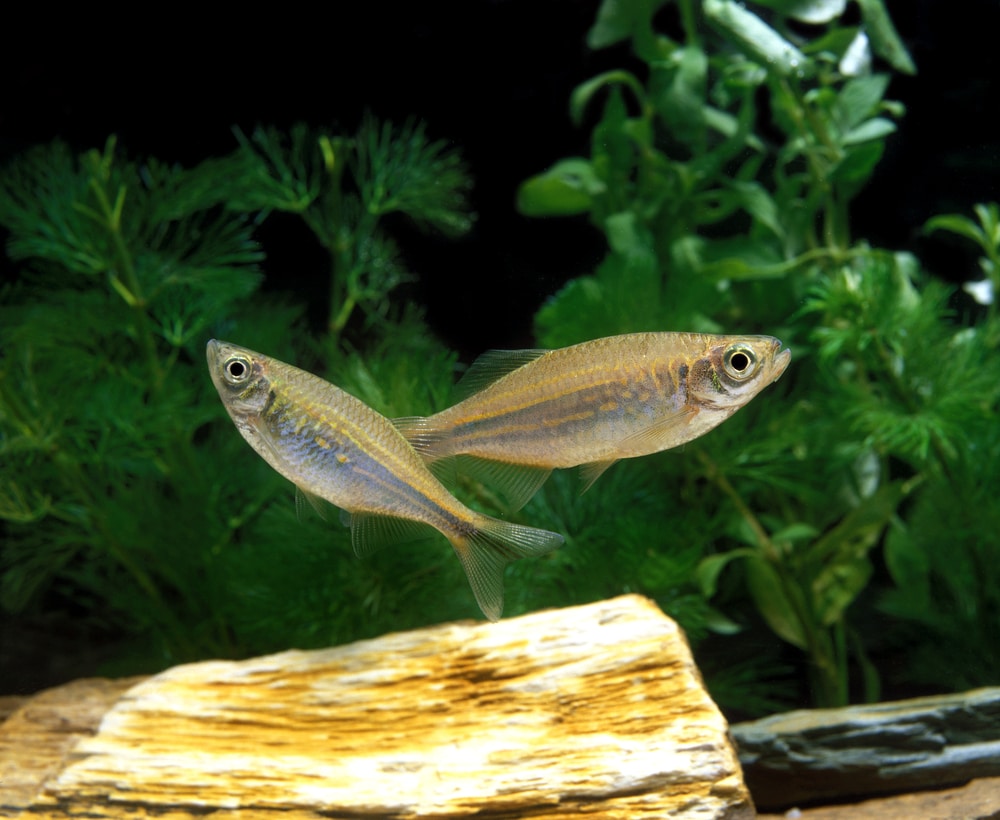
Giant Danios are excellent Dither Fish for aquariums with large fish. As busy schooling fish they signal to less confident fish that there are no predators lurking.
Jack Dempseys are predators in their own right but Giant Danios are too large to snack on and too fast to be caught when the Dempsey is in a bad mood.
Giant Danios tend to stay in the middle to upper water column, leaving the Jack Dempsey plenty of space to rule. They are also hardy and eagerly eat any live or prepared foods small enough for them.
Since they are schooling and should be kept in groups of at least 6 individuals Giant Danios are for 55 gallon aquariums or larger.
- Scientific Name: Devario aequipinnatus
- Origin: South Asia
- Size: Up to 5 inches
- Temperament: Peaceful; schooling
Rainbowfish
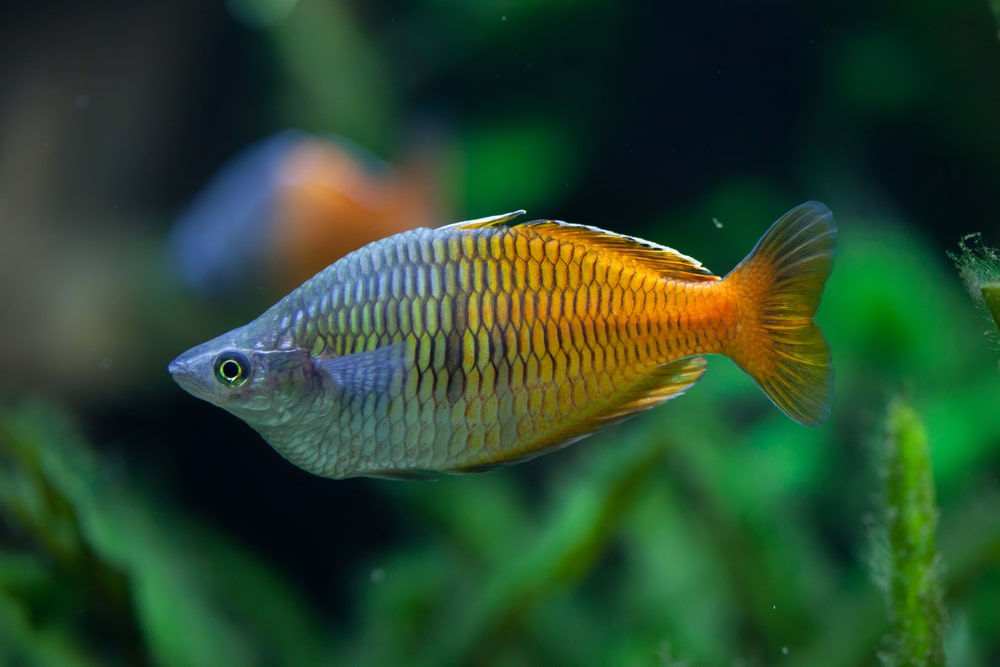
Rainbowfish are a diverse family and include fish less than an inch long and large species such as the 8 inch long Red Rainbowfish (Glossolepis incisus).
Other sizeable species that make great tank mates for Jack Dempseys include the Boesman’s Rainbowfish (Melanotaenia boesemani) and Regal Rainbowfish (Melanotaenia trifasciata).
Like Jack Dempseys, Rainbowfish prefer neutral to alkaline water conditions with plenty of rocks. While medium to large in size they are peaceful community fish quick enough to avoid a Jack Dempsey.
Rainbowfish are some of the most vividly colored dither fish you can buy but you’ll need at least a few of the dull colored females to get the best show from the males!
- Scientific Name: Melanotaeniidae family
- Origin: Australasia
- Size: Up to 8 inches
- Temperament: Peaceful; schooling
Silver Dollars
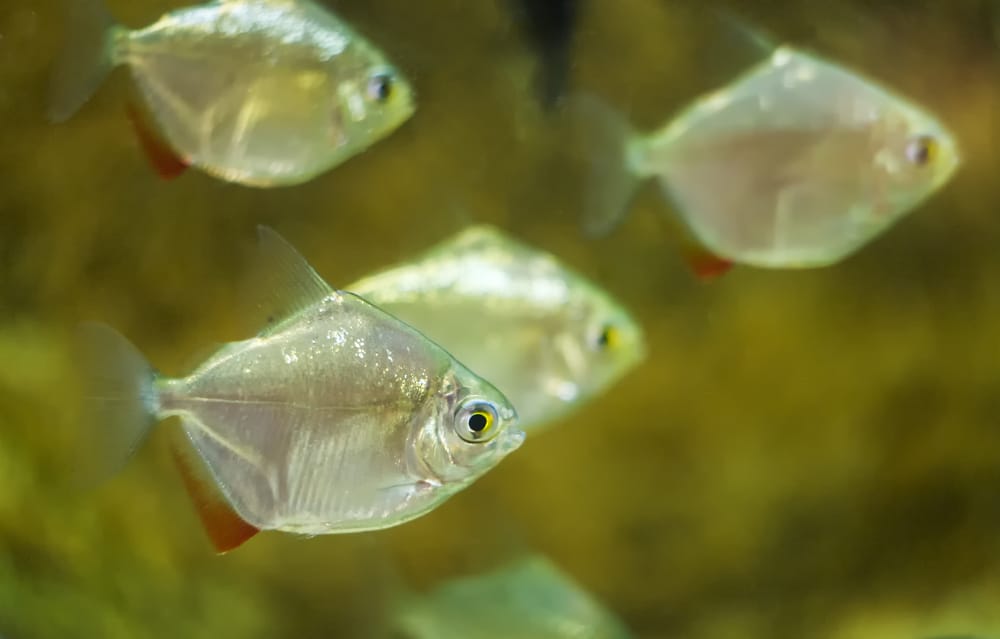
Silver Dollars are popular dither fish for aquarists with extremely large aquariums because they school in the hundreds in nature.
Their sides are covered in mirror-like tiny scales that catch light in a mesmerizing way. Combined with their round shape it’s easy to see how they get their name.
Silver Dollars are Characins and thus closely related to the tiny Neon Tetra, but are grouped in the subfamily Serrasalminae. They share this classification with the fearsome Piranha and massive Pacu, two other schooling Characins native to South America.
Silver Dollars aren’t as toothy as either Piranhas or Pacu but still have strong teeth and love to eat anything vegetarian. All of your plants will be on the menu for a group of Silver Dollars, even tough, bitter species like Anubias.
Be sure to supplement their diet with vegetarian prepared foods and blanched vegetables whenever possible!
- Scientific Name: Metynnis species
- Origin: South America
- Size: Up to 8 inches
- Temperament: Peaceful; schooling
Tinfoil Barbs
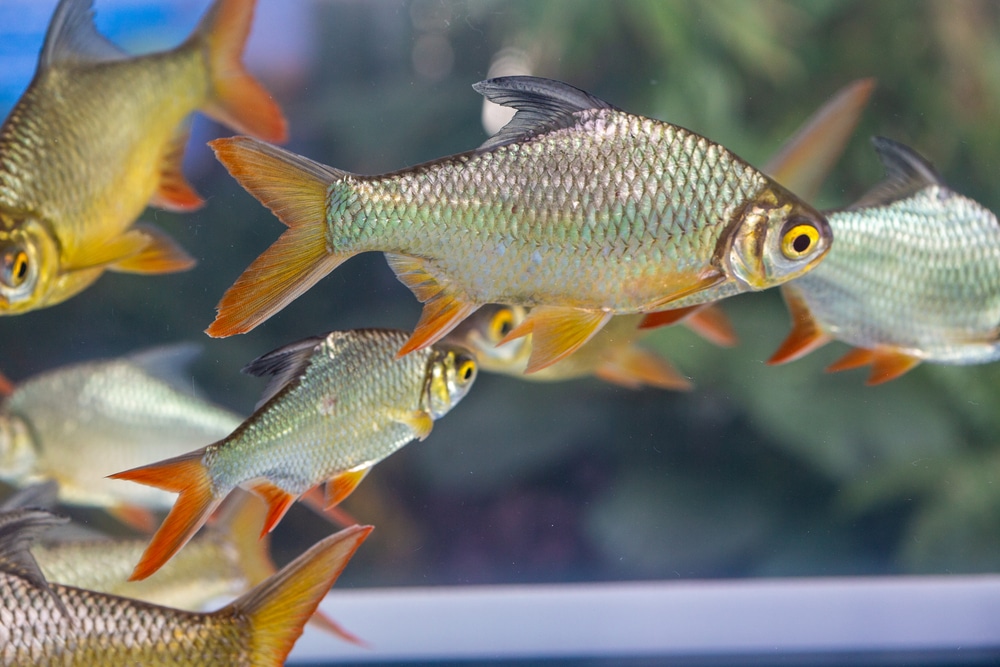
Tinfoil Barbs grow as long as a Jack Dempsey but are relatively thin. They also prefer being kept in schools, making them ideal for large aquariums. Like scaled-up Tiger Barbs, Tinfoils are very fast, boldly swim in the midwater zone, and happily eat any prepared or fresh foods offered up.
Thanks to their schooling nature, fast swim speed, and large size, Tinfoil Barbs will avoid or weather aggression from most cichlids but should not be confined in tanks where they are forced into a Jack Dempsey’s territory continually.
They are also fairly skittish and should never be kept in aquariums smaller than 55 gallons. If panicked or being chased by a Dempsey in a small tank they can rocket straight past an aquarium lid and end up on the floor!
- Scientific Name: Barbonymus schwanenfeldii
- Origin: Southeast Asia
- Size: 14 inches
- Temperament: Peaceful; schooling
Blind Cave Tetra
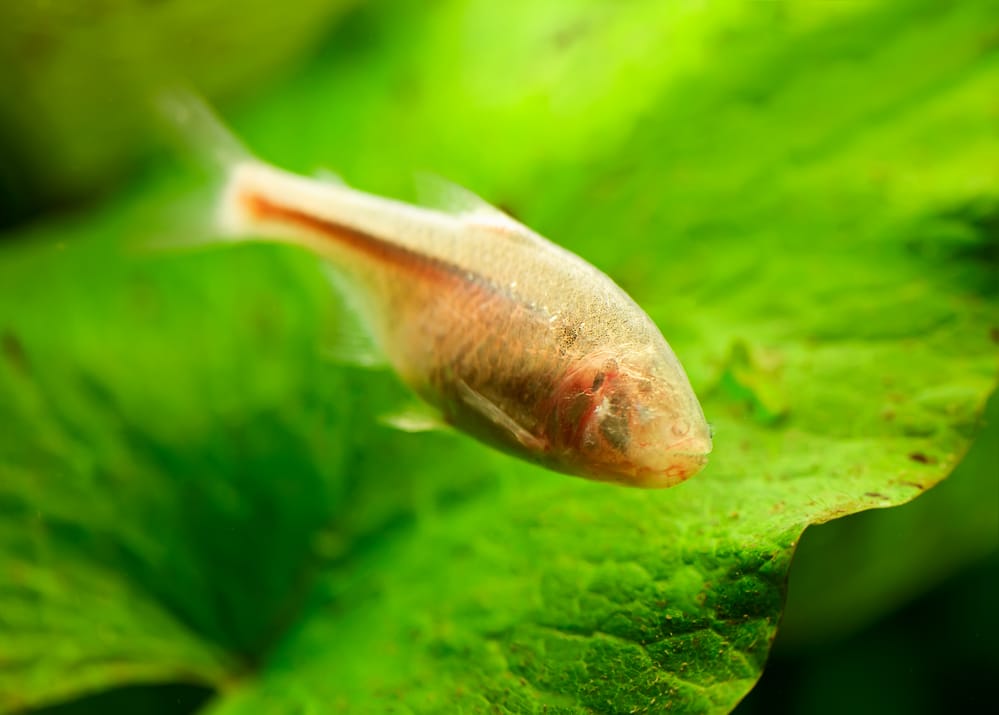
Blind Cave Tetras are some of the most unusual fish you’ll ever see in the trade. They evolved from Mexican Tetras that have been swept into the cave systems of the Caribbean coast.
Over thousands of years they have lost their eyes and pigmentation while evolving especially sensitive lateral line and olfactory senses to take in their environment.
While eyeless Blind Cave Tetras have no trouble sticking together in a school, avoiding obstacles and finding food. Their delicate pink color is different from most aquarium fish and they are too large to be eaten by a Jack Demspey when fully grown.
Since Blind Cave Tetras entirely lack eyes they are often active at night and occasionally turn semi-aggressive, nipping at sleeping tank mates in hopes of finding weak or dead prey. However they rarely disturb larger fish.
- Scientific Name: Astyanax mexicanus
- Origin: Mexico, Texas
- Size: 4 to 6 inches
- Temperament: Peaceful; schooling

